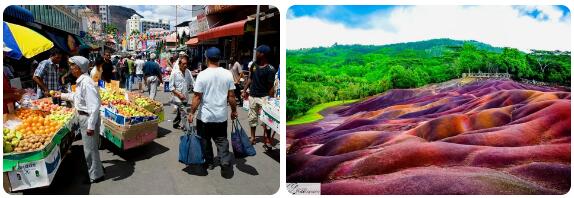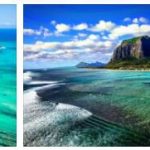Mauritius: population and cities
Population
According to Countryaah website, Mauritius has about 1.3 million residents.
Ethnic composition
About 2/3 of the Mauritians have roots in India. Another large ethnic group are the Creoles, i.e. former slaves from Africa and Madagascar, who have mixed with other ethnic groups (mainly from Europe. Another 2% are of Chinese descent. The rest is made up of a white minority. There are indigenous people in Mauritius not because the island realm had been uninhabited before the colonizers arrived.
Religion
to Hinduism as committed half of Mauritians. The second largest religious group is Christianity with about 32.5% – with 27% Catholics and 5.5% Protestants. The third largest denomination is Islam, which in Mauritius follows the Sunni direction in particular, even if there are a small number of Shiites who are politically and economically quite influential. Buddhists are represented in Mauritius with around 0.2%.
National language
In addition to the official English language, there is French, which is spoken as the mother tongue of 4% of Mauritians and almost only the upper class. Meanwhile, the French language dominates the public space and the most influential media in the country. The everyday slang spoken by almost everyone in the country is Morisyen.
It is a Creole language based on French. More than 80% of Mauritians consider it their mother tongue. Morisyen is even said to become the country’s official language one day. In any case, there are political efforts to achieve this. Other languages in Mauritius are mixed forms of North Indian dialects and languages that are very similar to Hindi and are spoken by about 12% of Mauritians, as well as Dravidian languages that come from South India. Of course, the Chinese sometimes communicate in different southern Chinese dialects. While Rodrigues is also spoken of as Rodriguais, the Agalega Islands are dominated by Agalega Creole.
Capital and other cities
Beau Bassin-Rose Hill
Mauritius’ second largest city currently has around 105,000 people who keep the city in the Plaines Wilhems district alive. The city has existed since 1877, was previously called Blondeauville and is the birthplace of the writer Loys Masson. Masson was born in 1915 in a town that attracted many businessmen and traders in the 18th and 19th centuries thanks to its sugar factory. Beau Bassin-Rose Hill is – as the name suggests – a twin town. It consists of Beau-Bassin and Rose Hill, founded in 1868. According to Abbreviation Finder, MUS stands for Mauritius in English. Click to see other meanings of this 3-letter acronym.
Curepipe
79,000 people make Curepipe the fourth largest city on the island of Mauritius. The name is derived from the English cure pipe (dt. To clean pipes) because the European conquerors stopped in Curepipe to clean their pipes during their travels between Mahébourg and Port Louis. In the middle of Curepipe is the extinct volcanic crater Trou aux Cerfs, in English deer hole. Also worth seeing is the Mare from Vacoas, five kilometers away, the largest water reservoir on the island.
Port Louis
The largest and capital of Mauritius is Port Louis, a metropolis with 170,000 residents on the Indian Ocean. The economic and cultural heart of the island is very pretty and full of very interesting sights. These include the citadel with its good view over the roofs of the city, the UNESCO-protected Aapravasi Ghat, the Blue Penny Museum with an unstamped Blue Mauritius, the Minakshi Temple for the Tamil population and the Le Caudan Waterfront, one at the harbor shopping street, which can also be seen on the back of the 50 rupee banknote.
Quatre Bornes
Quatre Bornes, also city of flowers, has almost 79,000 residents and is the fifth largest city in Mauritius. It is located on a plateau in the Plaines Wilhems district and about 15 km from Port Louis.
Vacoas-Phoenix
Vacos-Phoenix is a twin city that was created in 1963 through the merger of the two namesake towns. About 100,000 people live in the third largest Mauritian city, which spreads out so wonderfully on a plateau in the Plaines Wilhems district.
Mauritius: geography and map
The illustration shows an overview of the island state of Mauritius in the Indian Ocean. With a number of rivers and cities – including the location of the capital Port Louis and the Grand River South East. Check topmbadirectory for politics, flags, famous people, animals and plants of Mauritius. There are also some smaller islands around the main island. The rights to the representation are held by Goruma. The island of Mauritius covers an area of 1,860 km². Thereof:
- ForestAround 22% of the country is forested.
- Meadow, pasture landAround 3% of the land is used as meadow or pasture land.
- Arable land and fieldsAround 49% of the land is used as arable land or fields, especially for growing cane sugar, which is grown on around 90% of the agriculturally cultivated area.
The Republic of Mauritius consists only of islands and therefore has no common border with any state. The total length of the coast to the Indian Ocean is 180 km.
Note
Great Britain’s decades of rule over the Chagos Archipelago violate Mauritius’ right to self-determination, according to the International Court of Justice (ICJ). Therefore, Great Britain has to return the archipelago, which also includes the US military base Diego Garcia, to Mauritius. The court had to examine whether the separation of the Chagos Archipelago from the British colony of Mauritius in 1965 – around three years before the island state became independent – was lawful. Great Britain leased Diego Garcia, the main island of the archipelago, to the USA in 1966. As a result, the approximately 1,500 residents had to leave the island after the US established a military base there in the early 1970s.
Longitude and latitude
The island of Mauritius extends over the following geographical latitude (abbreviation Δφ) and geographical longitude (abbreviation Δλ):
| Δφ = from around 19 ° 59` to 20 ° 32` southern latitude Δλ = from around 056 ° 18` to 057 ° 50` eastern longitude |
You can find detailed information on this subject under Longitude and Latitude.
Legal time
For Mauritius, the following value applies to Central European Time (CET), i.e. the time (without summer time). A minus sign means that it is earlier there, a plus sign that it is later than CET:
| Δt (CET) = + 3 h |
Further and detailed explanations of the time can be found under Time zones, time.
The highest point of the sun in Port Louis
The capital Port Louis is located at a southern latitude of around φ = 20 ° – and thus in the tropics.
If the declination δ of the sun has reached the value of 20 ° south and the image point of the sun is thus exactly above the city or island, the sun is perpendicular there. This happens exactly twice a year, roughly 14 days before December 21st and 14 days after December 21st (for details see position of the sun).
Attention
If the image point of the sun and thus the declination δ is north of the latitude of Port Louis, and this is the case around eleven months of the year, the sun is not in the south at noon, as in our latitudes, but in the north. In this case, the sun moves from east to north to west, where, like us, it sets.
mountains
The highest point in the country is the Piton de la Petite Rivière Noire with a height of 828 m. Further surveys are:
- Le Pouce with an altitude of 811 m.
- Mont du Rampart with a height of 777 m.
- Mont Cocotte with a height of 771 m.
Rivers
The longest river in the country is the Grande Rivière du Sud-Est.
Another river is the Rivière des Creoles.
Lakes
The largest lake in Mauritius is the Mare aux Vacoas. Other larger lakes are:
- La Nicolière
- La Ferme
- Valetta
- Piton du Milieu
- Eau Bleue
The Indian Ocean
Mauritius is located in the middle of the Indian Ocean – part of the Pacific.









